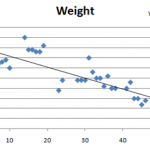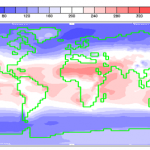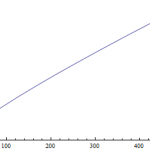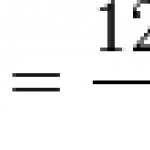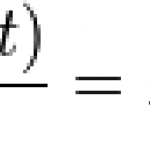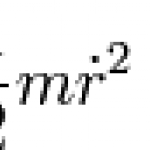
All right, here's a fun one. It usually comes as part of a story. The story as told is mostly true, though a few details have been a little fudged by the winds of history. It goes like this: when the young Carl Gauss was a small child in school, his teacher wished to kill some time by making the students practice their addition by adding the integers from 1 to 100. Gauss worked for about 10 seconds and turned in the correct answer. His method was exceptionally clever. By doing the problem twice he made the calculation much easier.
First he wrote down the problem, calling the unknown…
ScienceBlogs' Razib is back from the Singularity Summit, with summaries of a good portion of the proceedings and some interesting links. Relatively recently I've written about why the Singularity very well may not happen (at least not the wilder version) - roughly, the growth curve of technology may be logistic rather than exponential thanks to the limiting effect of physical laws.
Probably the most passionate proponent of the Singularity is Ray Kurtzweil, and according to a piece Razib links, he disagrees. (The piece itself is somewhat old, but apparently he presented an updated version at…
I shot an arrow into the air,
It fell to earth, I knew not where;
For, so swiftly it flew, the sight
Could not follow it in its flight.
- Henry Wadsworth Longfellow
This is what happens when you don't pay attention in freshman physics. You don't need to see where the arrow goes to find out where it lands, you just need the initial speed and angle. Two simple accelerated motion equations later, you have the range. The method isn't perfect since it fails to account for air resistance and other factors, but for finding an arrow it's a lot better than shrugging and giving up once you lose…
Apologies for the absence. A brand new research project is getting cranked up and I've been pretty short on time. As such the posting schedule may get a bit erratic. I'll do my best.
I'm also working on improving some other things as well. When I started college I somehow managed to avoid the freshman 15 (the weight lots of people gain during college), but nevertheless ended my four years about that much heavier. That wasn't a bad thing. Lots of it was muscle from doing a bit of working out, and I was pretty slight going into college in the first place.
The problem is that going into…
One of the nice things about energy is that there's many, many different forms of it. There's many, many different ways to convert between those forms.
Yesterday we discussed the problem of turning the energy in sunlight into electricity via the circuitous route of sunlight to electricity (in a space solar panel) to microwave beamed down to earth, to electricity in a field of antennas. The advantages are continuous operation and high collection efficiency, and of course the disadvantage is the truly head-spinning cost.
Solar panels on the earth's surface are also expensive, not always very…
In theory I like solar power a lot. There's a lot to be said for energy that falls from the sky for free for as long as we care to use it. But actually getting that energy to do useful work in an economical way. Solar panels are expensive and not terribly environmentally friendly to produce, and sunlight is only available during the day and only to the extent that the sky is clear. Getting energy to use during less sunny periods requires either lots of excess capacity during the day along with storage facilities, or alternate generation methods. The first is wildly uneconomical, the…
Sometimes in math we'll understand one aspect of a problem very well, while at the same time we understand another aspect of a problem very poorly. For instance, take the prime numbers. According to the prime number theorem, the number of prime numbers below x is approximately given by:
Where pi(x) is the prime counting function and ln(x) is the natural logarithm. As you keep counting your way up the number line, you'll encounter more and more primes. They thin out and become more and more rare, but nonetheless there's an infinite number of them as you keep going. The number that you…
Astronomers and space exploration enthusiasts around the web are expressing lots of enthusiasm for the discovery of water on the moon by the Indian Chandrayaan-1 orbiter. Long story short (Ethan has a good version of the long story), the probe discovered relatively large quantities of water frozen throughout the lunar soil just below the surface. It's not just at the bottom of craters in the polar regions, but instead seems to be quite widespread.
It's a big deal for a lot of reasons. From a pure science perspective, it's exciting to learn such a major and mostly unexpected fact about or…
Ideas about the nature of light have been around for thousands of years, but until Newton came along in the 17th century most of these attempts were little more than speculation. Newton himself held to the view of light as composed of huge numbers of tiny "corpuscles", or particles, which bounce of mirrors and are absorbed by dark objects, etc. It wasn't a bad idea, really. It explains shadows very well, for instance. If you stand in the way of particles, they can't go through you and so you'll leave a shadow behind you where the light particles have failed to hit.
Particles weren't the…
Every once in a while it's a good idea to remember that even the simplest-looking physical systems can have completely bonkers behavior. The pendulum is certainly one of those systems. It's so simple that it's a mainstay of freshman classes, for technical and non-technical majors alike, though even then we do have make an approximation that's only valid for relatively small angles of the swing.
But the equation of motion that a pendulum obeys is pretty simple. String a few pendulums together and the equation of motion is still not too bad - all you have to do is a little somewhat tedious…
Note to the reader: this post is relatively stiff mathematically. For those not mathematically inclined, I think you might enjoy reading it anyway and enjoying it as you would a tour of a widget factory; even if you're not worried about the details of the nuts and bolts, it's fun to see it done.
While watching football yesterday, I got a phone call from a great friend whom I first met in our halcyon high school days. He's a fellow physics student a few years younger than me, calling to discuss a problem in contour integration. Most people like watching football more than they like doing…
The vast majority of the functions we've talked about over all these Sundays have been ones that are expressible as a relationship between two numbers x and y. Sometimes the relationship is simple, sometimes it's fairly complicated. Mostly though, we just work according to the function as though it were a little machine. Take a number x, do to it what the function tells you to do, and the result is the number y. This is a function where the relationships between x and y are given in a very clear and explicit form.
But a function doesn't have to be given in that way. The only requirement…
I note an interesting short piece by James Hrynyshyn about a bit of a local controversy in Nova Scotia about the installation of a tower to provide wireless internet to the area. Leading the opposition is a guy worried about the health effects:
"I think over a period of time it will change the DNA of the garlic because it shakes up the molecules," he said Tuesday.
EastLink uses microwave transmission to provide high-speed internet access to rural areas outside its wired network.
Levine said he moved to the country to get away from pollution, and he sees the radiation from the towers as…
Let's say you've got a water molecule. It doesn't have to be water, but it helps if it's one we can easily picture:
You can imagine water vapor as an ensemble of many of these molecules flying and bouncing around in their container. This translational motion is not the only kind of motion they're executing. They're also rotating, and each impact with another molecule can change the speed and direction of that rotation. Not only are the molecules translating and rotating, they're also vibrating. The relative positions of the two hydrogen and one oxygen atom are not fixed rigidly, but in…
One of my fellow ScienceBloggers, ScienceWoman, has made a few waves by saying the following:
I am against accommodating our full-time worker, part-time graduate student students by moving a significant number of our classes to evening hours. There I said it. I don't want to make life easier for someone who is working very hard to get through her education while supporting herself in full-time employment.
She allows that this sounds harsh, but gives some good reasons for her opinion as a professor of -ology. (She doesn't say which science, but presumably we can eliminate the physical sciences…
Anybody heard of the idea of The Singularity? Roughly, it goes like this: technological progress builds on itself, and this self-reinforcing feedback loop is eventually going to come to a head where humanity makes a quantum leap into an unknowable and godlike transhuman technological future - possibly as early as the middle of this century. The name of the idea comes from mathematics, where approximately speaking a singularity is a place where a function rockets off to infinity. Alternately, some adherents of this type of thinking believe that progress is exponential; formally this doesn't…
Eight years ago today a terrorist group attacked and killed more than three thousand people. Nothing I can say can improve on what other have said in the memory of this horror, and nothing I can say will change any opinions about what followed.
I would, however, like to express my bitterness and disappointment on the failure to do the one thing almost everyone agreed upon even before the smoke cleared. There was only one right, proper, and American thing to do: rebuild. Rebuild the twin towers as they were, with an extra few feet in height as an act of defiance. Even building a different…
All right, time for an actual example of this gravitational force law I've been ruminating on for the last two days. Today we'll look at an alternate version of the gravitational potential that's truly screwy:
The first thing to notice is that it's not finite as r becomes very large. Among other things, that means there's no such thing as an escape velocity in a universe with this kind of gravity. What goes up really must come down.
To say more, we ought to take a look at the effective potential, which takes into account the angular momentum of the orbiting object. We'll write that…
One of the first great discoveries of modern physics was Newton writing down the equation for the force of gravity between two massive objects. The discovery was monumental not because it was complicated, but because it was profound. You can state the law in plain English very briefly. "The gravitational force between two objects is equal to their masses multiplied together, divided by the square of the distance between them, and multiplied by a particular universal constant to get the overall scale right."
This is the way things are, classically. But as far as we know there's nothing…
I'd like to do a little bit of classical mechanics, but the particular thing I want to do is a little hefty for one post. We'll split it in two. Today I'll set the stage and tomorrow we'll use it to solve an interesting problem.
The problem involves the orbit of a planet in a gravitational field, and fortunately the initial approach to the problem is not complicated. First we write everything in terms of energy. The total energy of a system is the sum of its kinetic and potential energy. Kinetic energy is the energy associated with motion, and potential energy is (in the case of orbits)…


